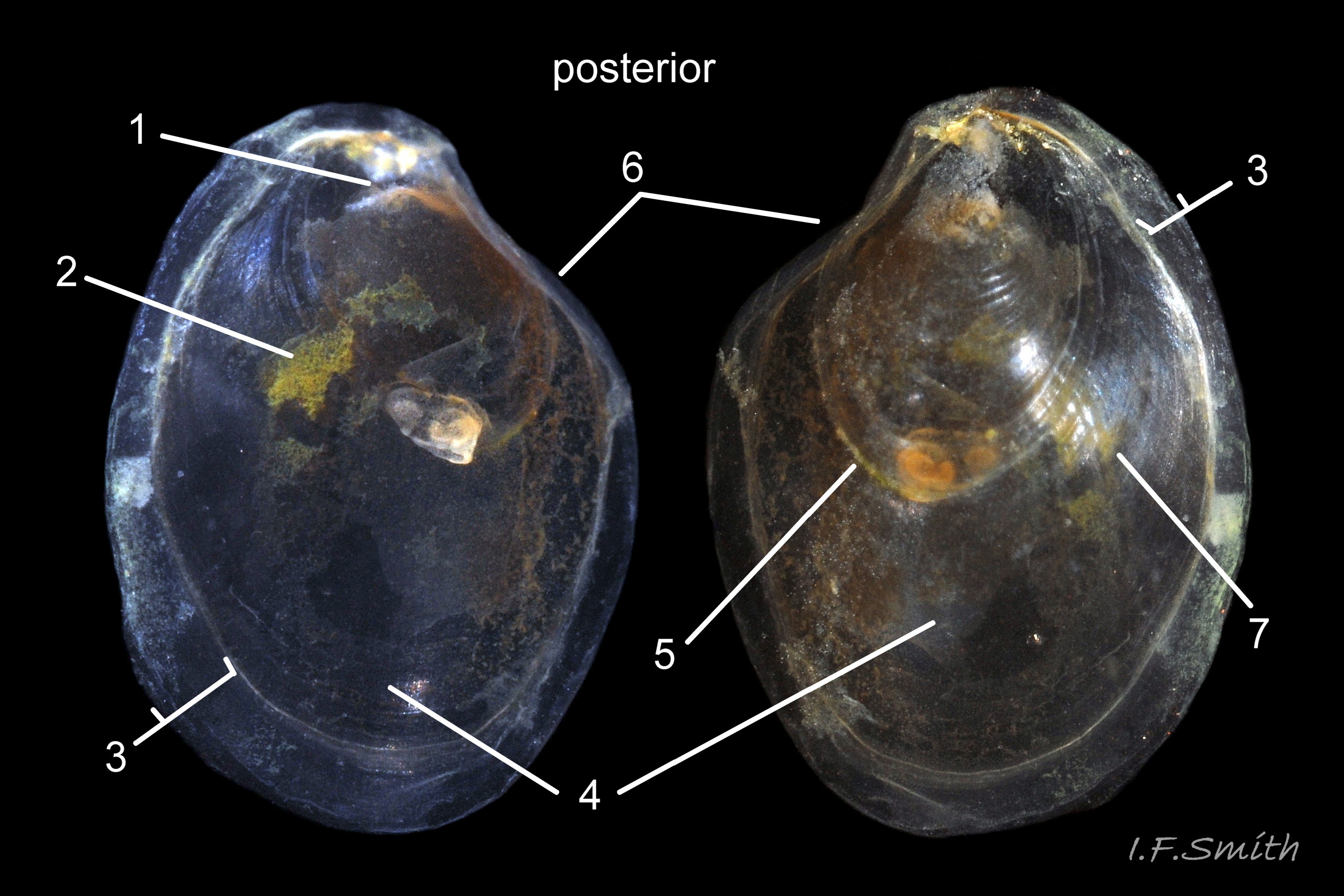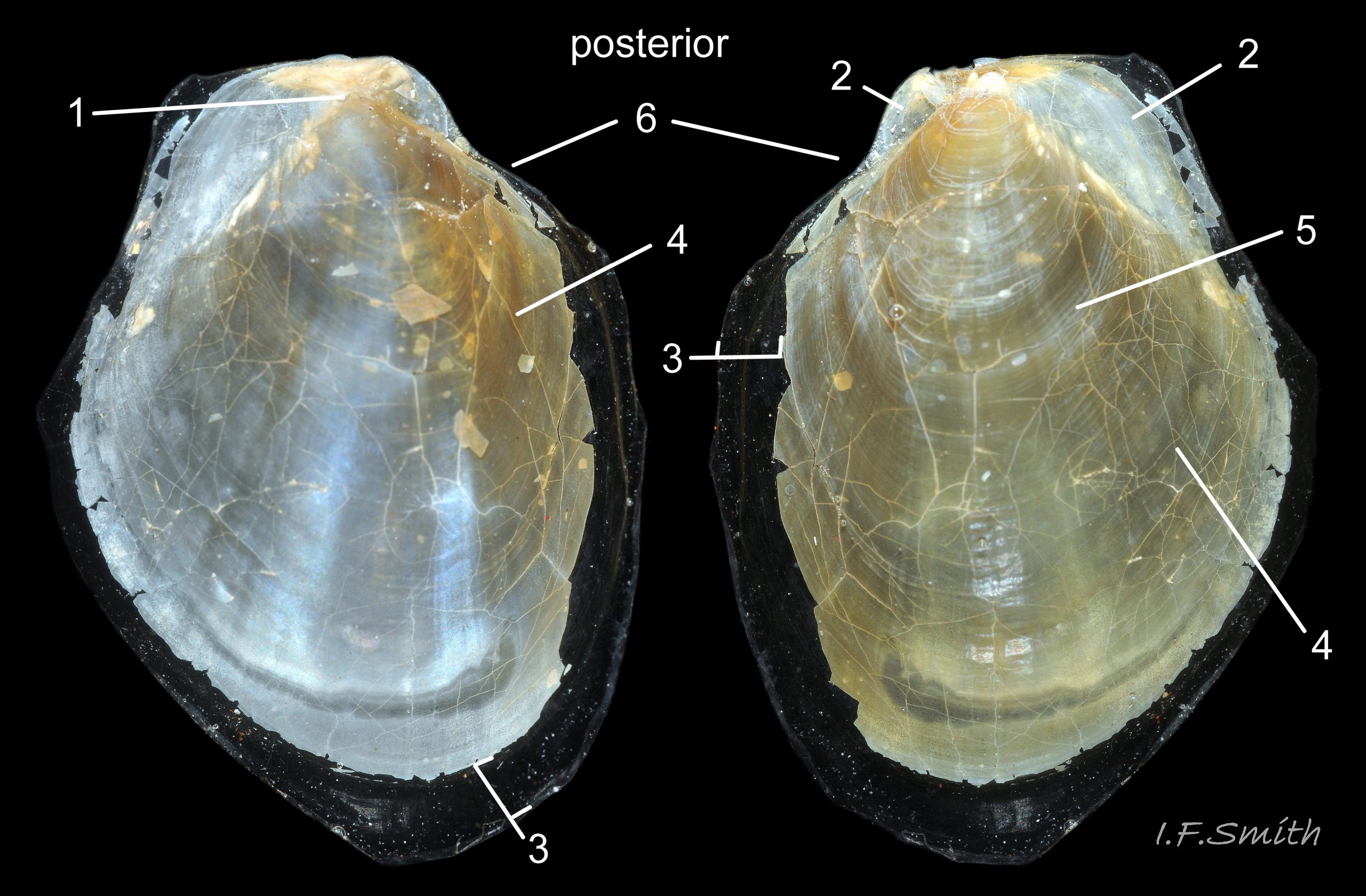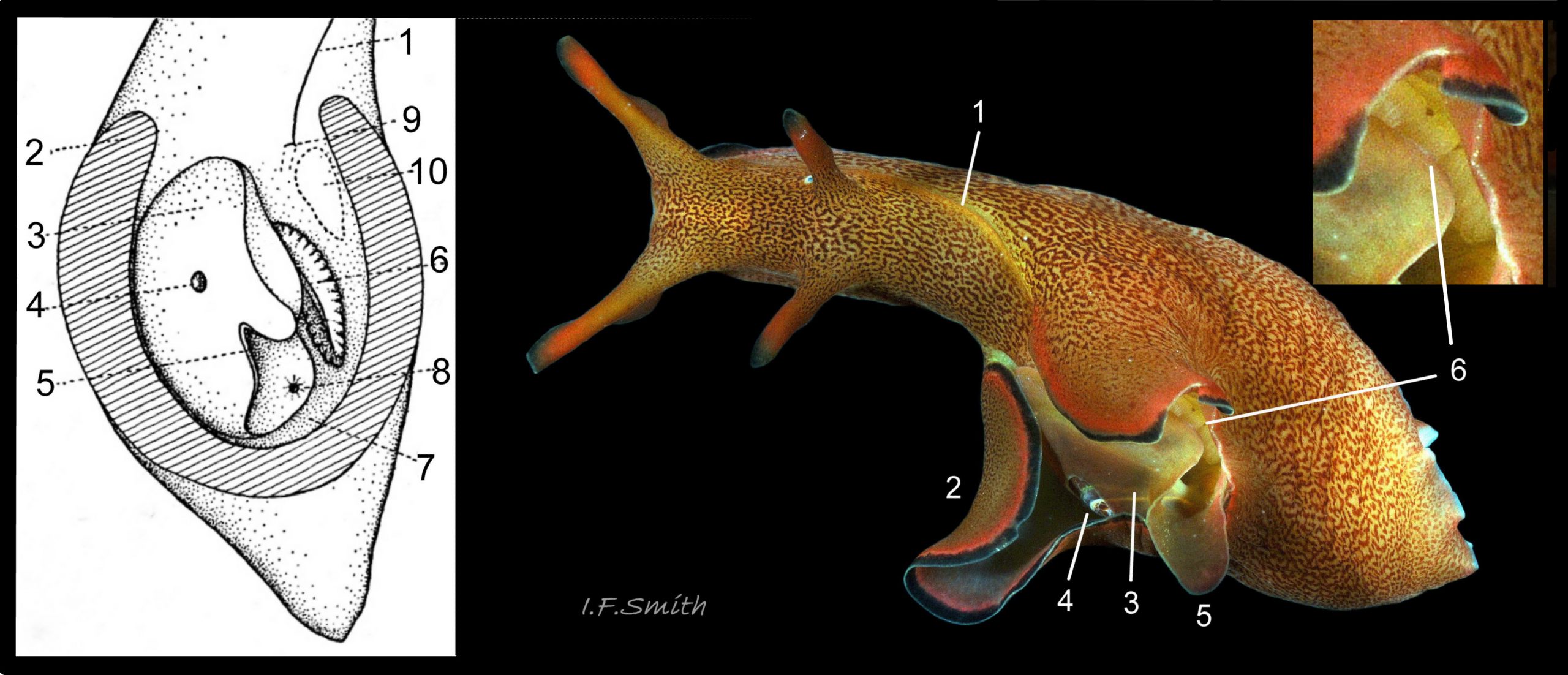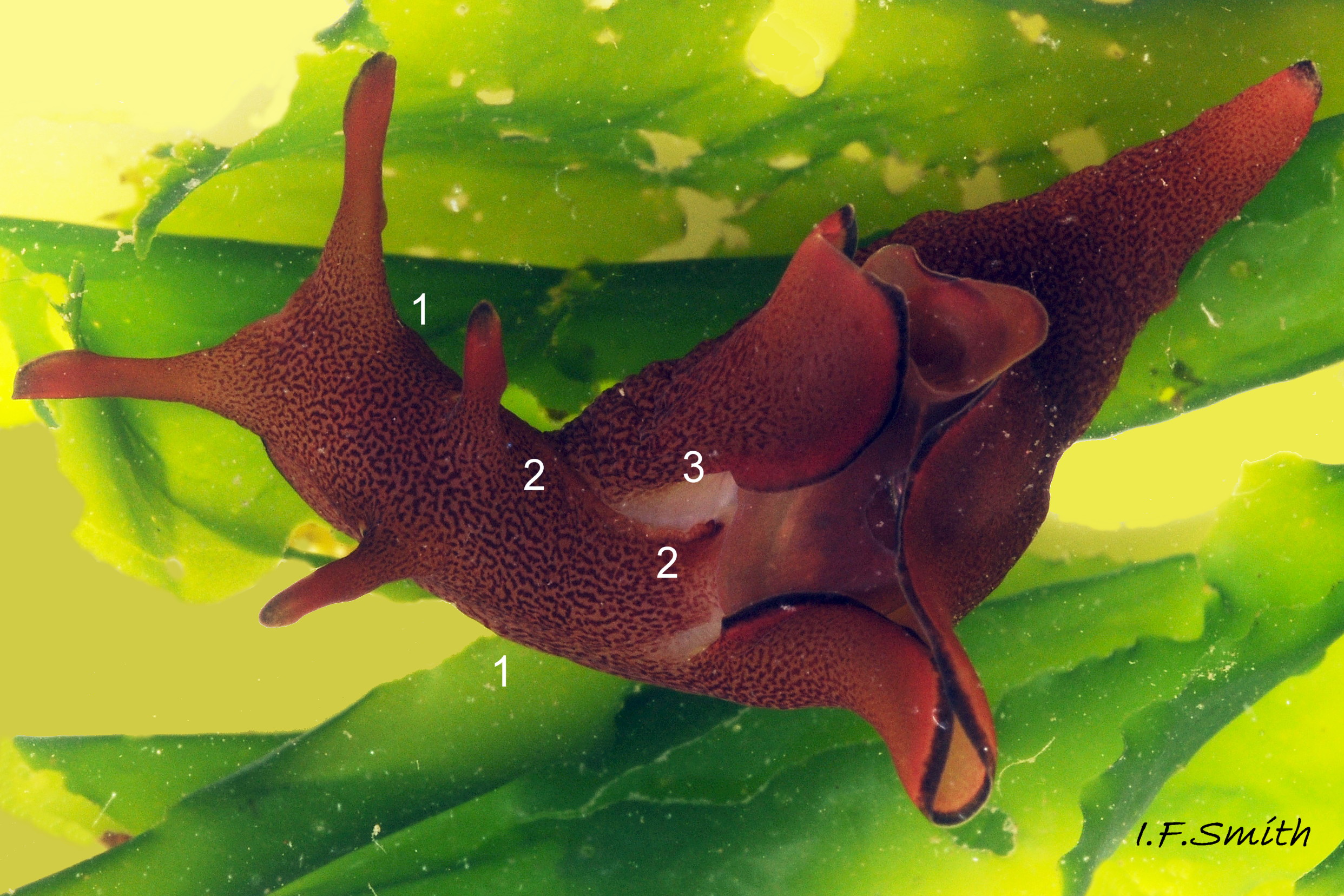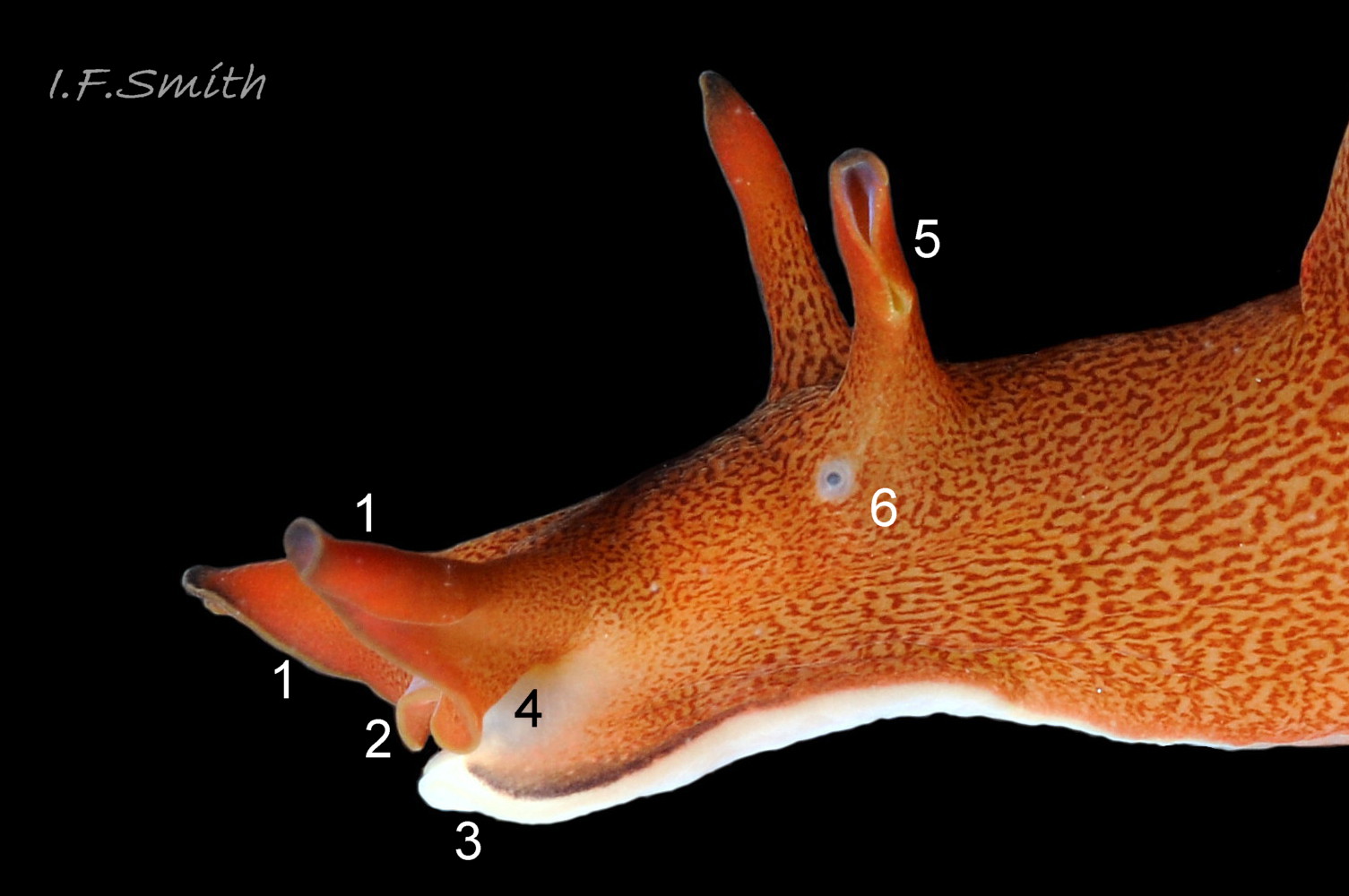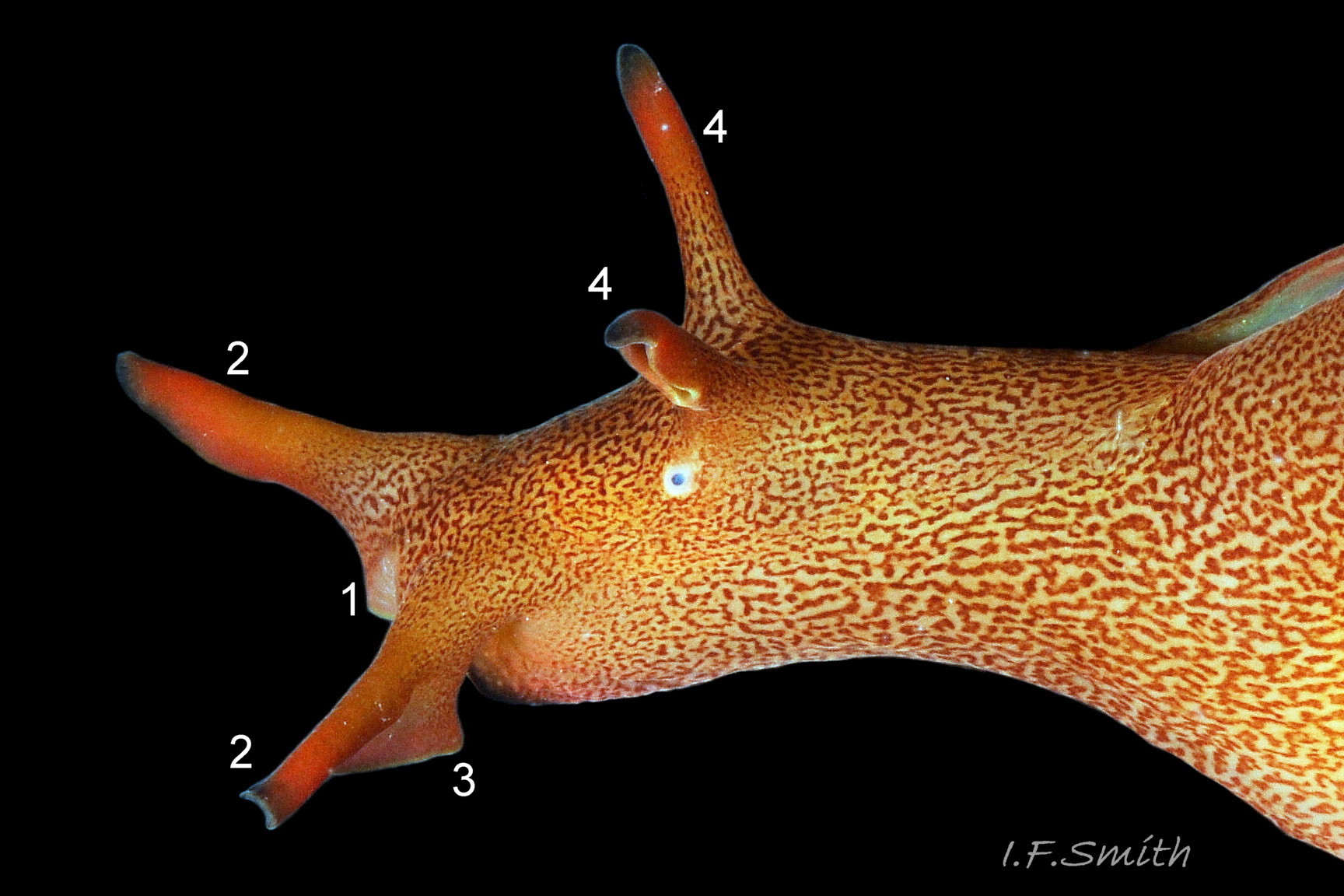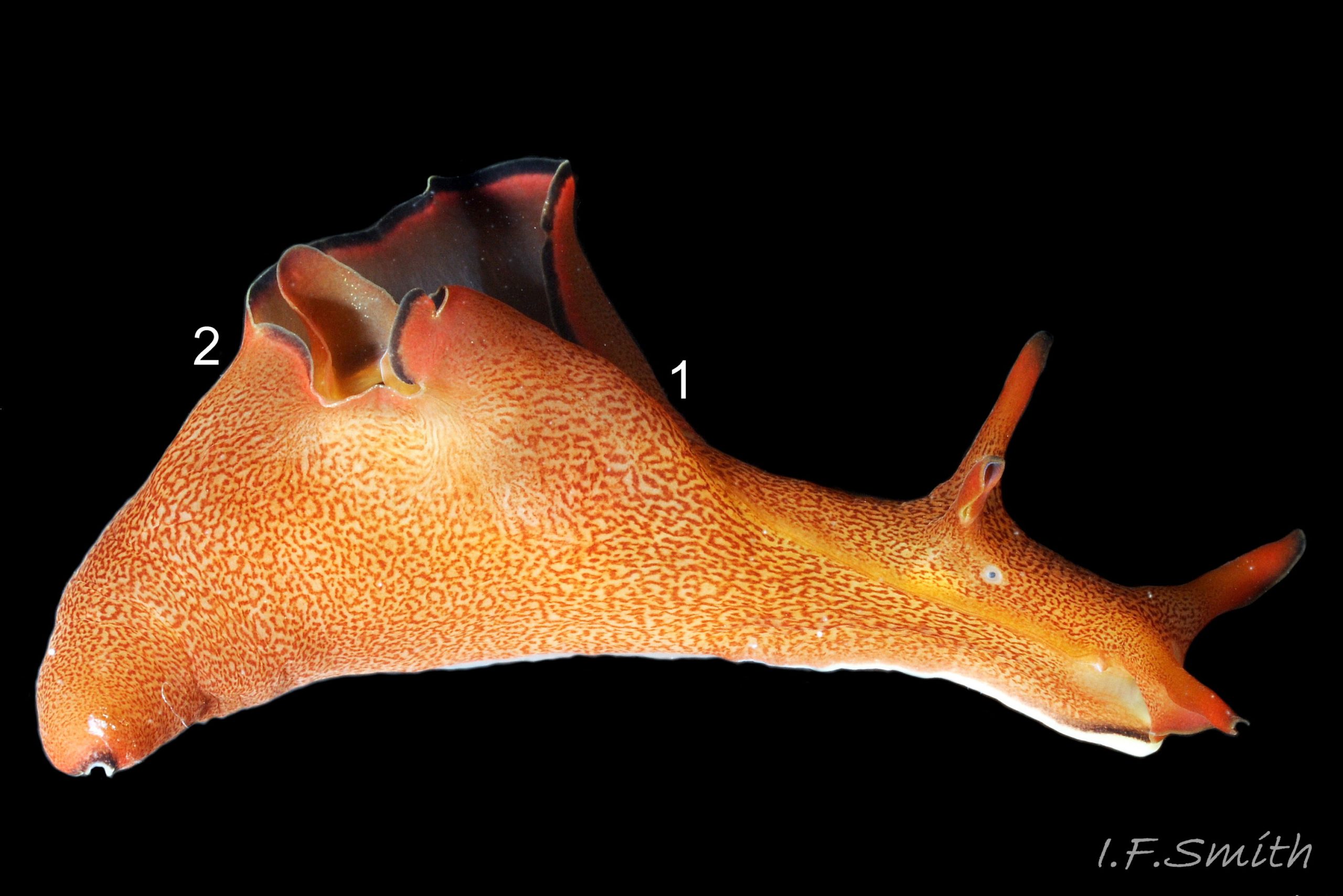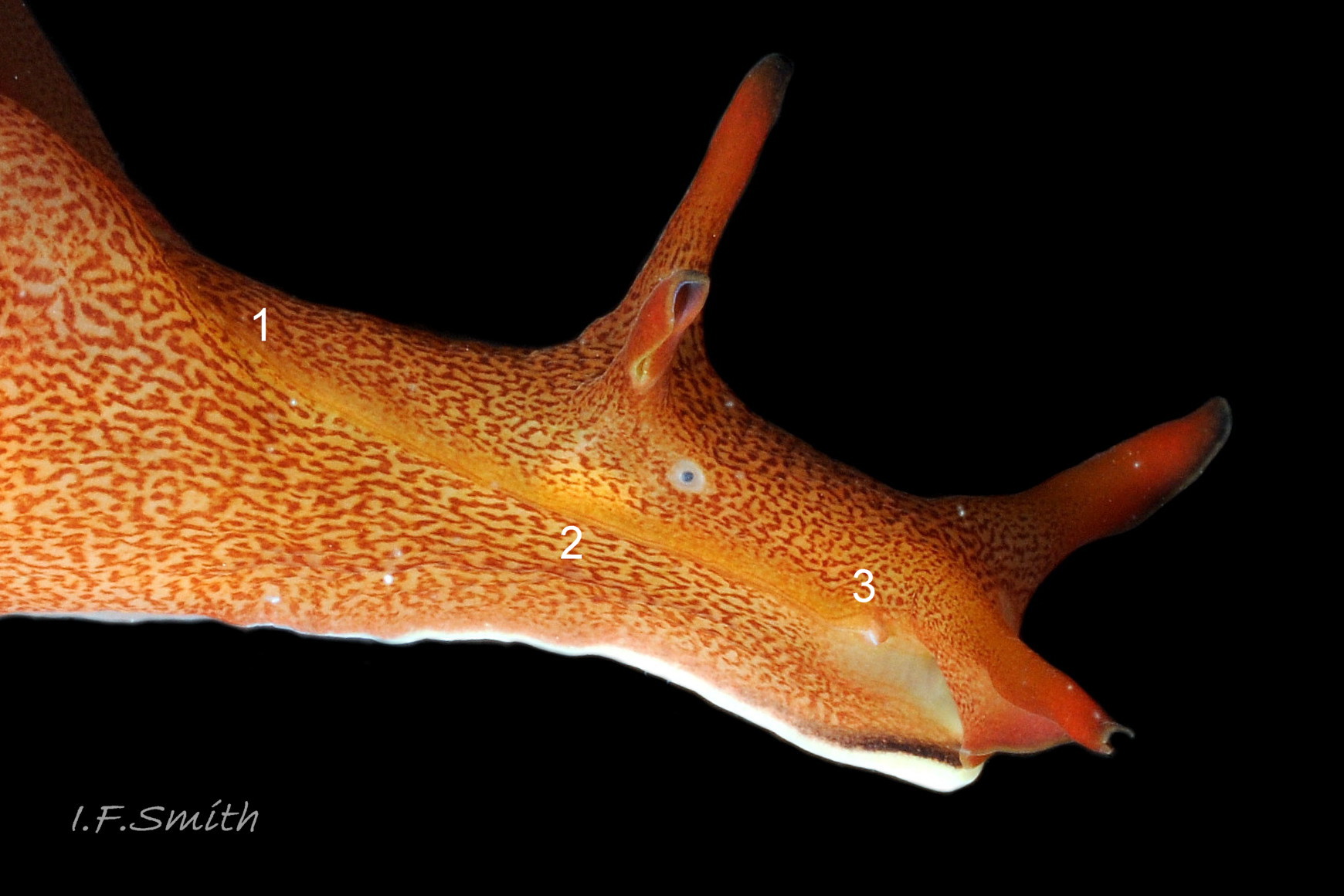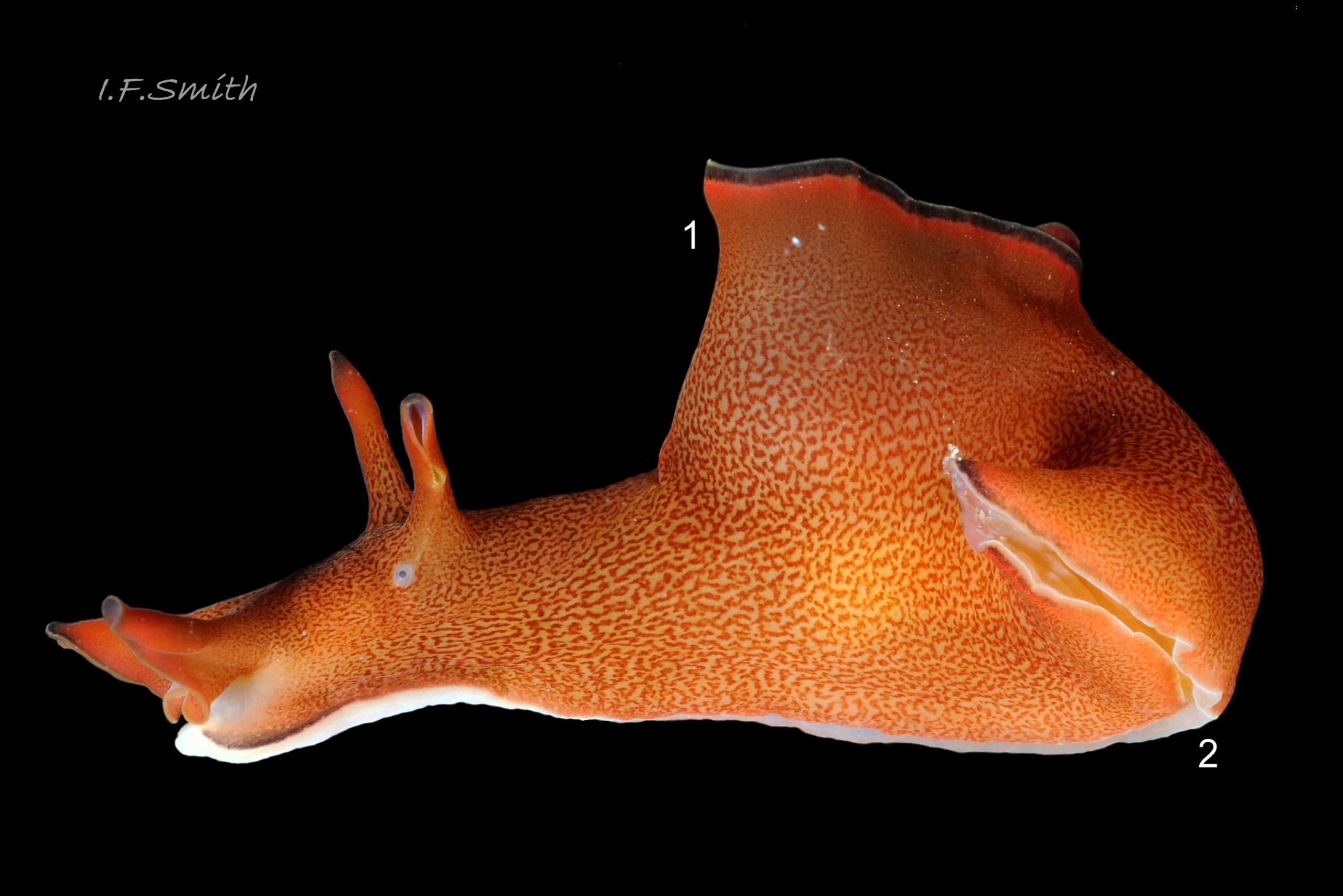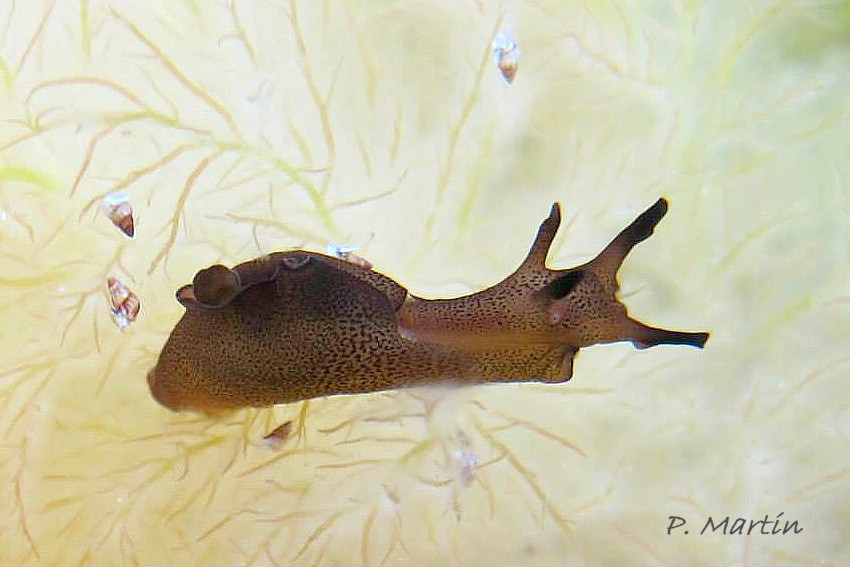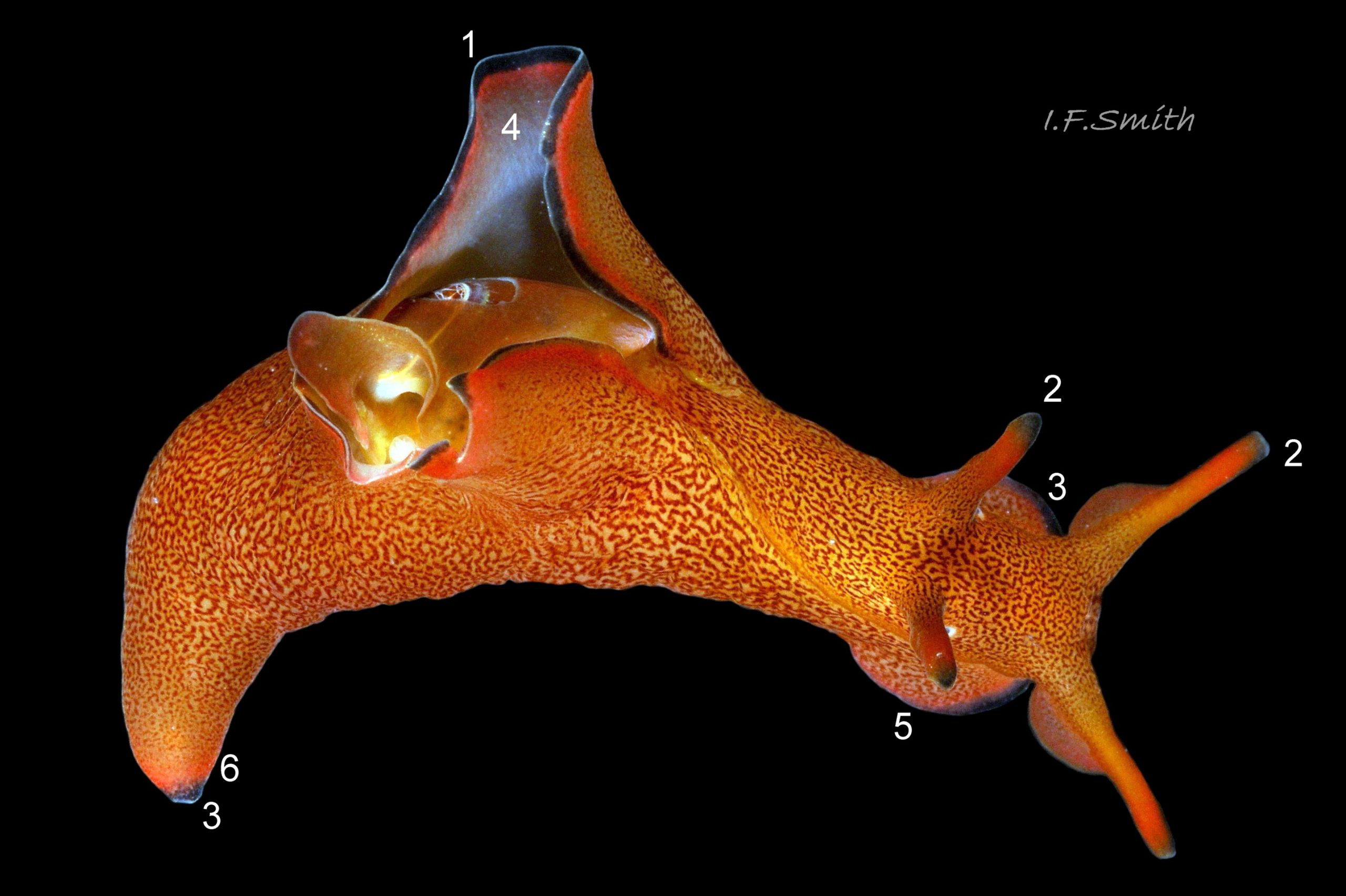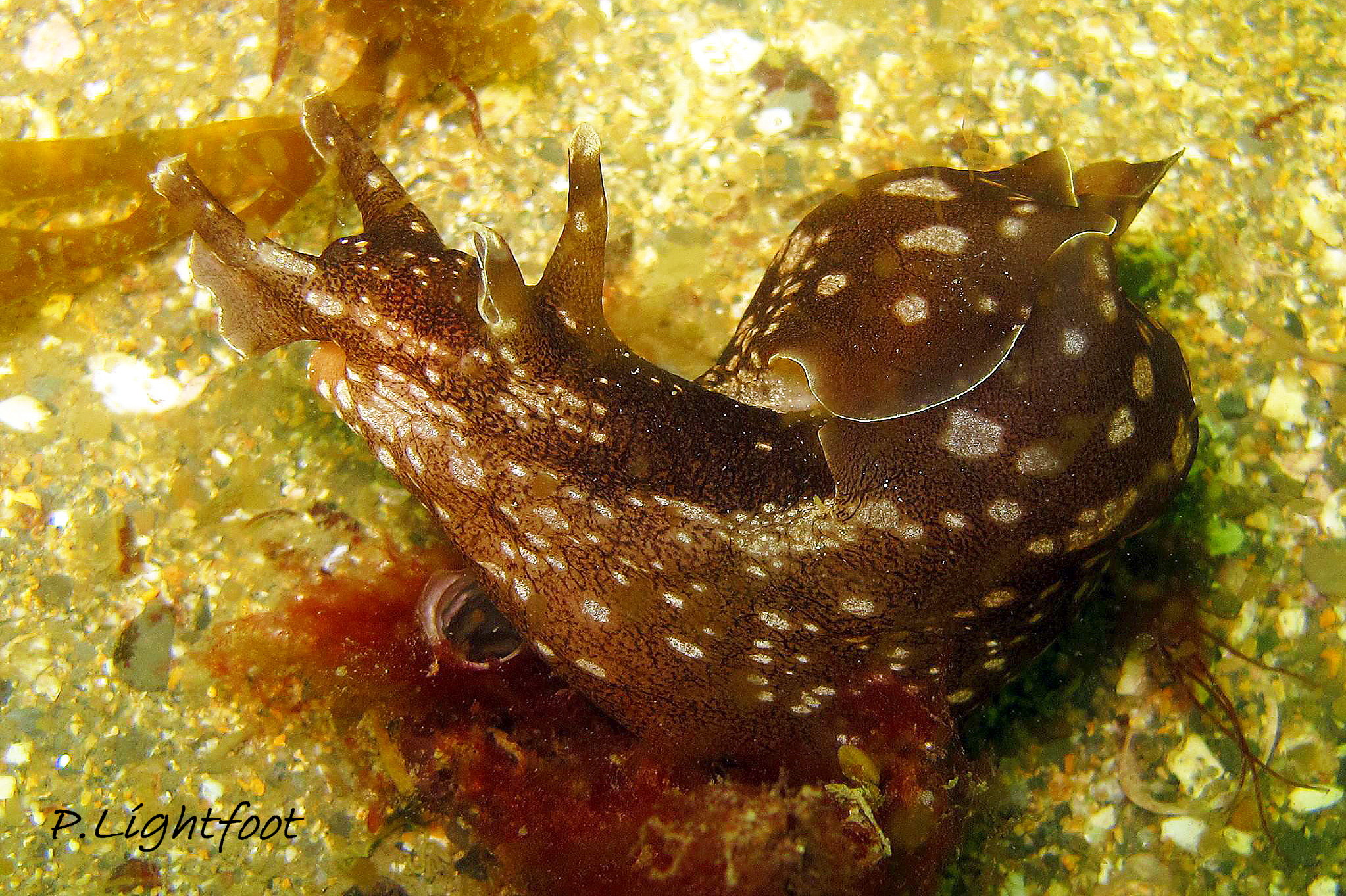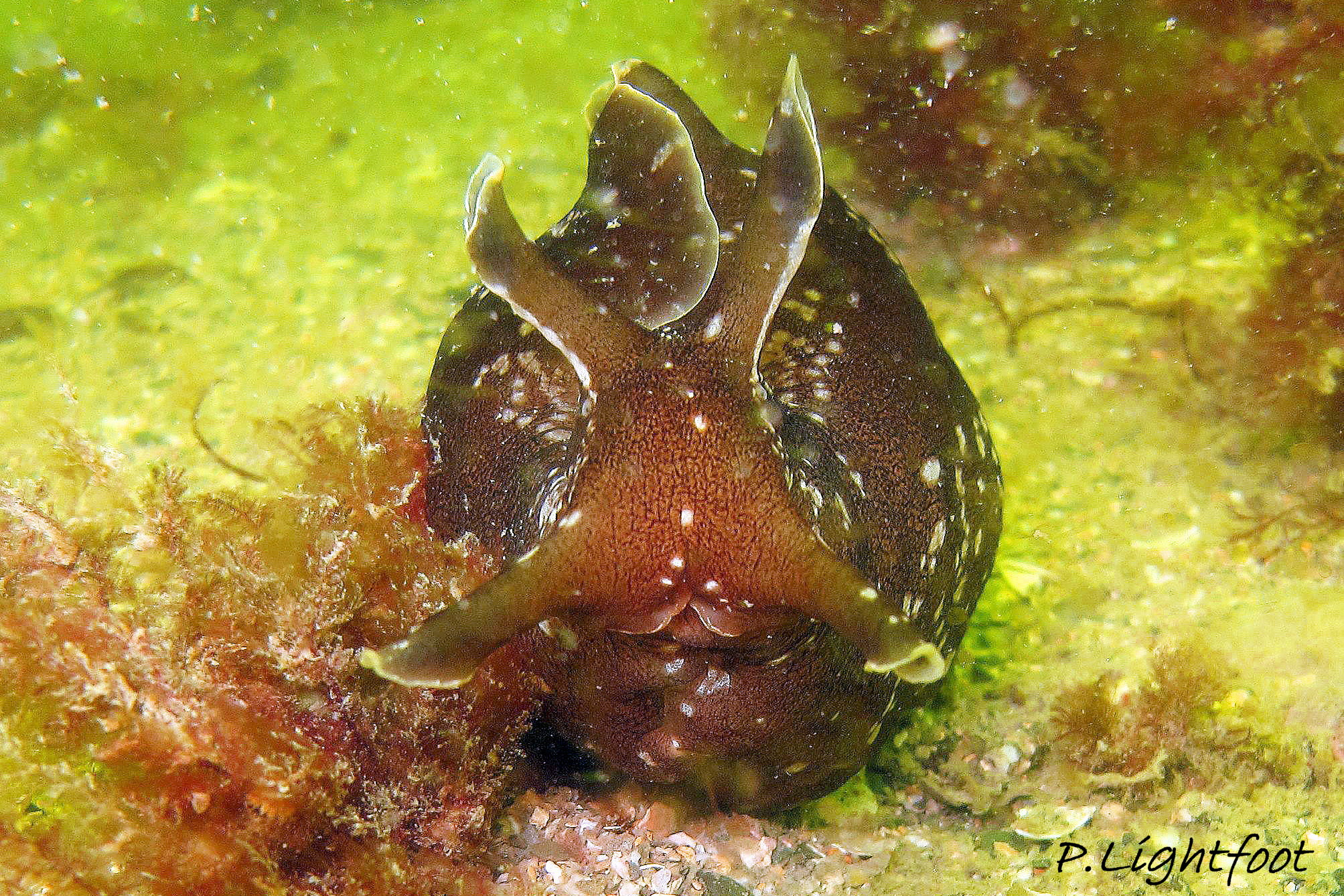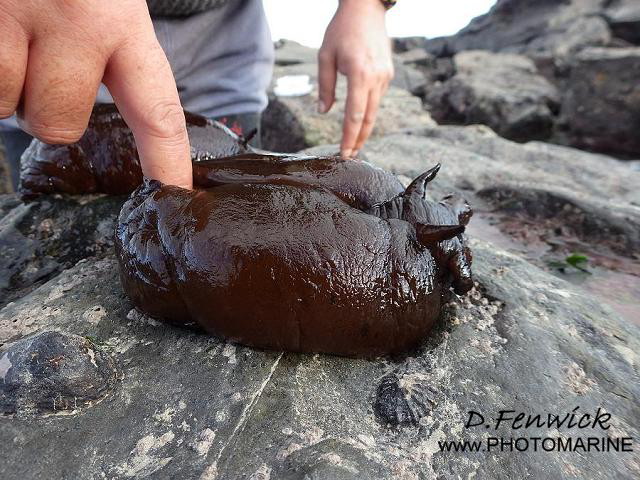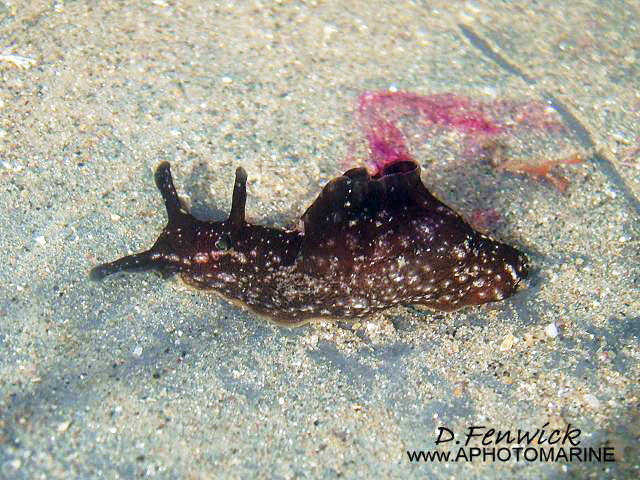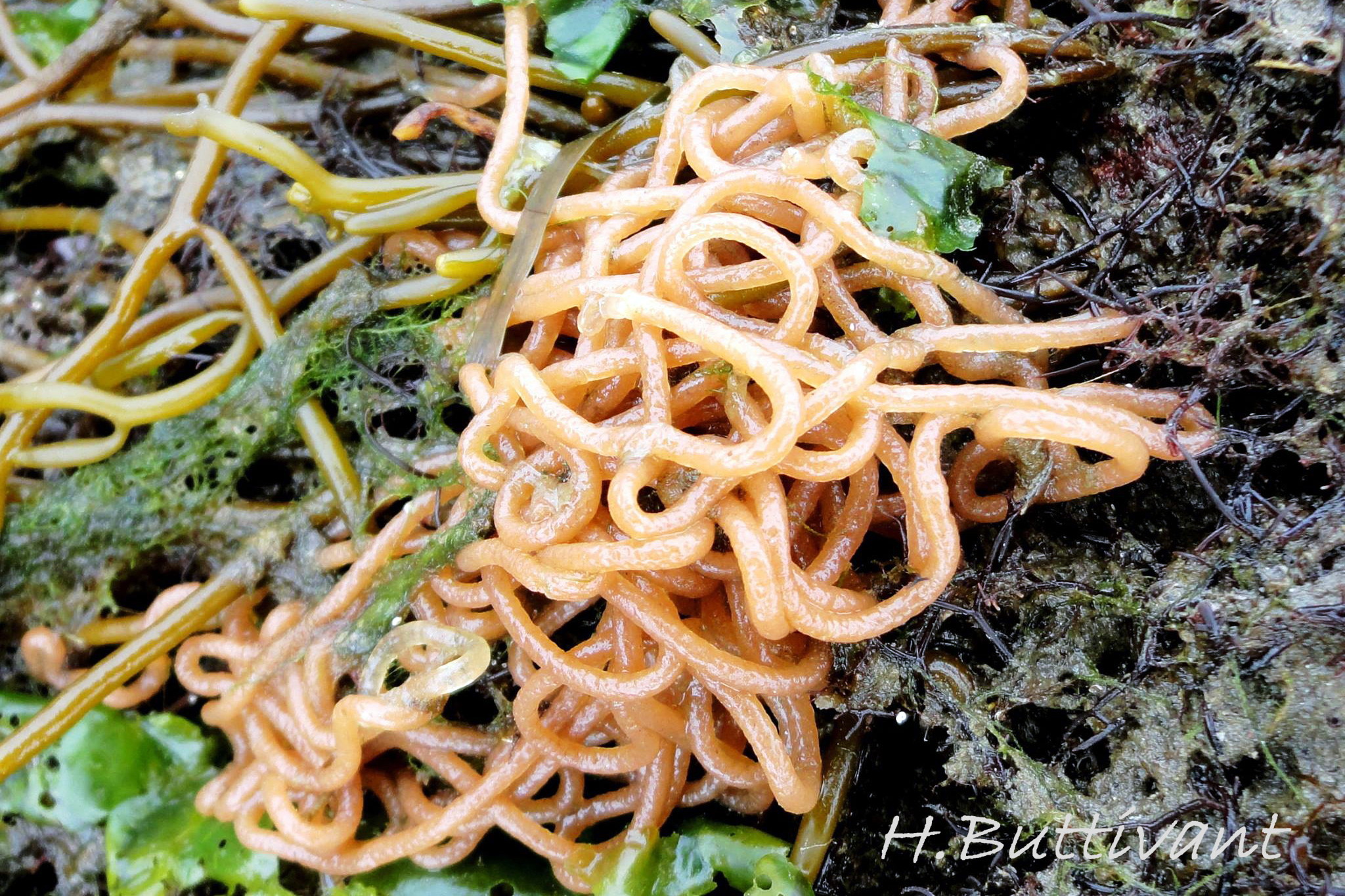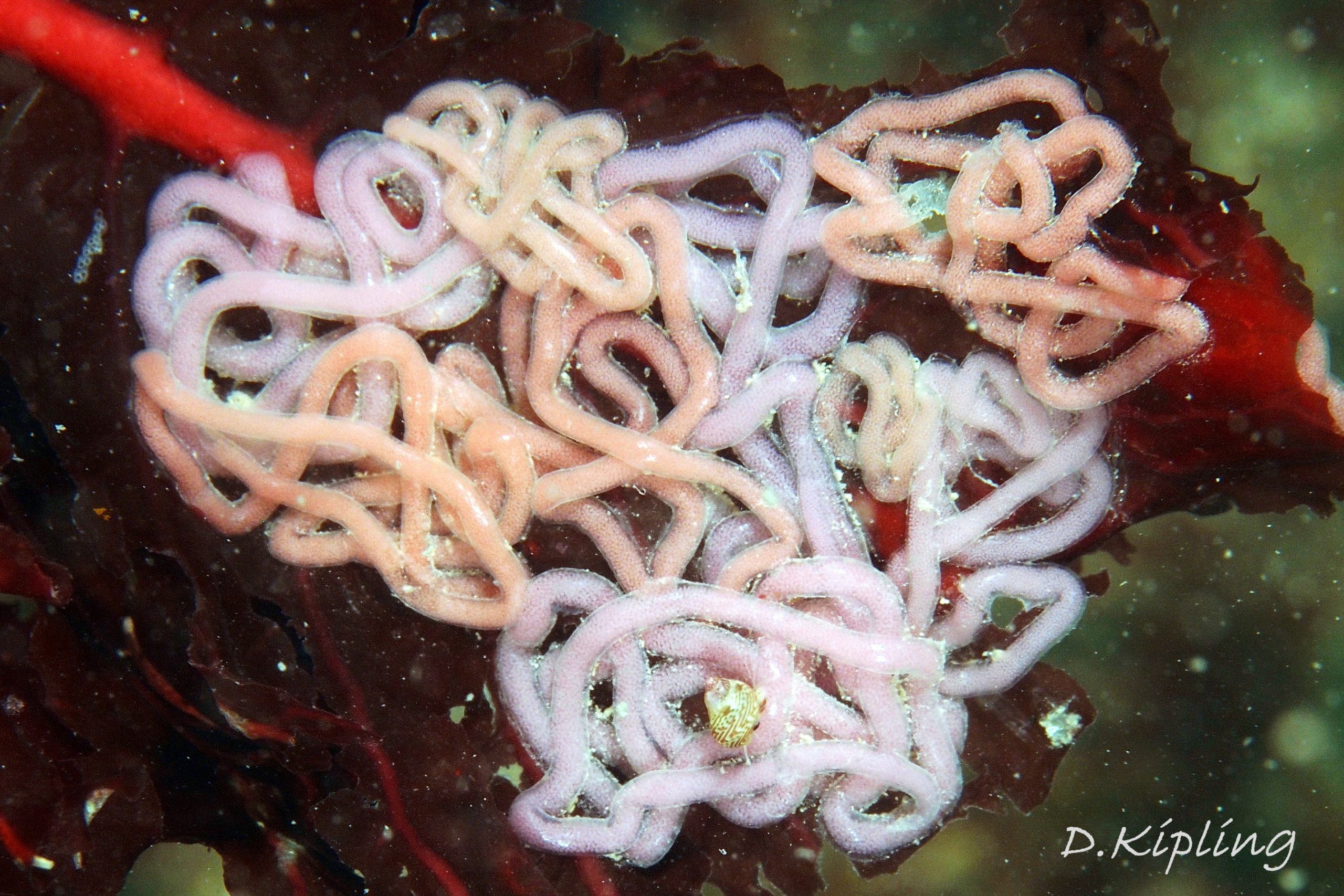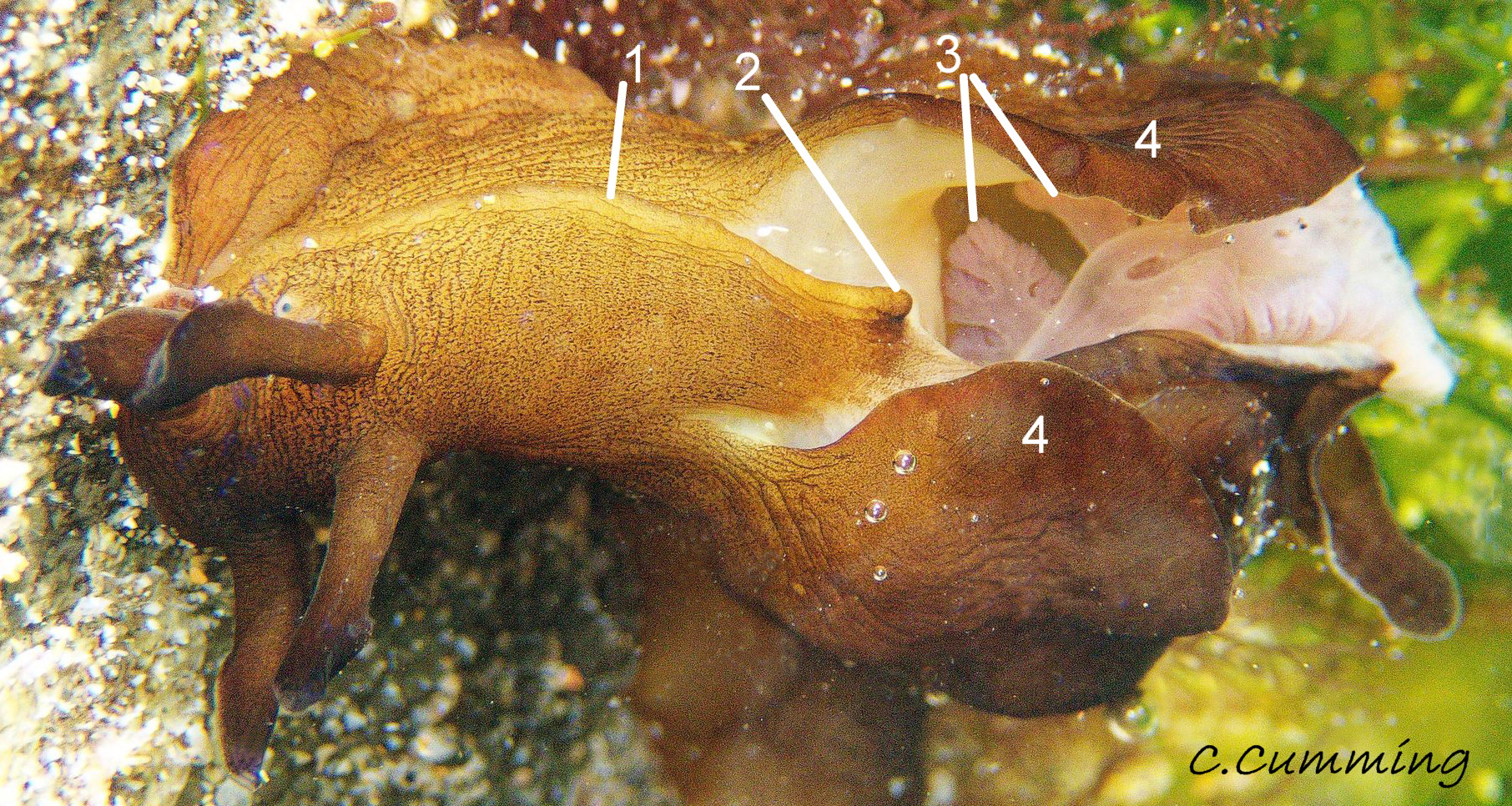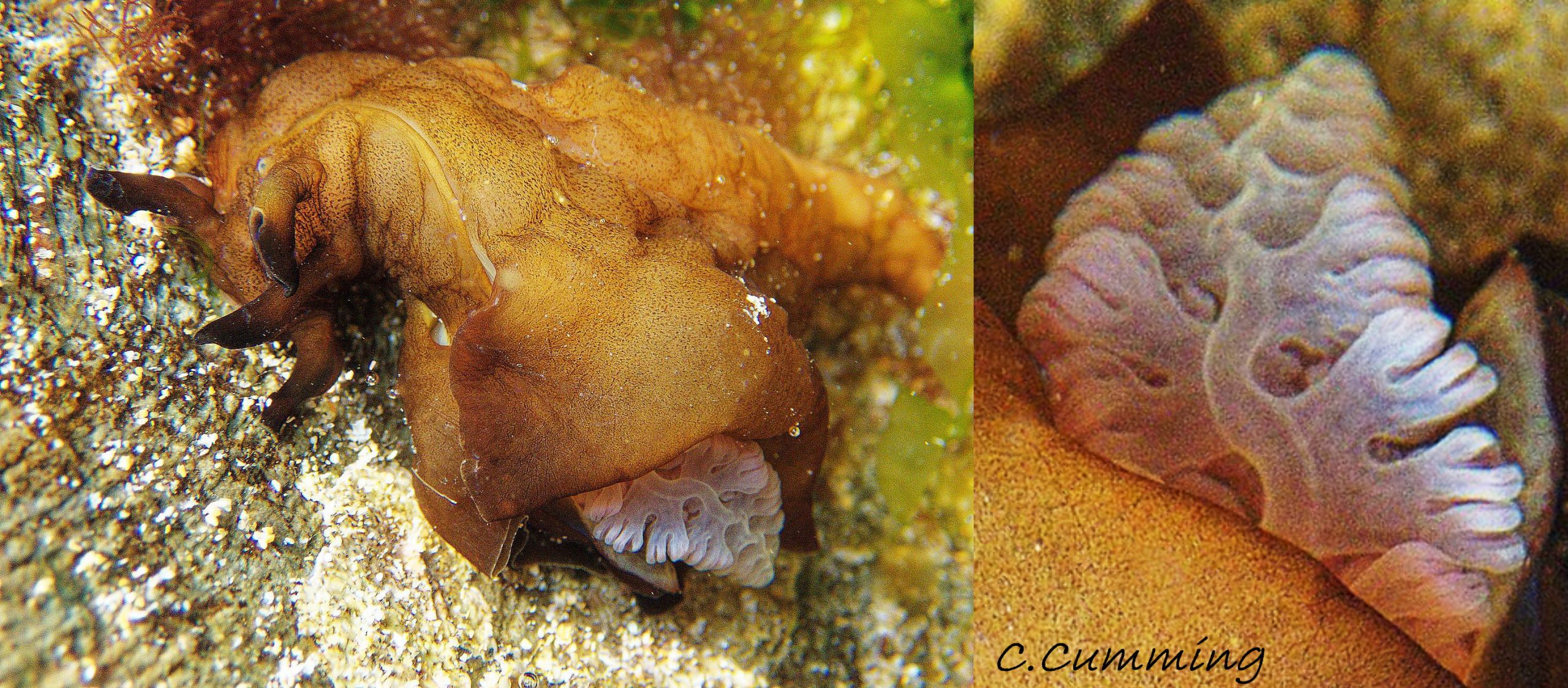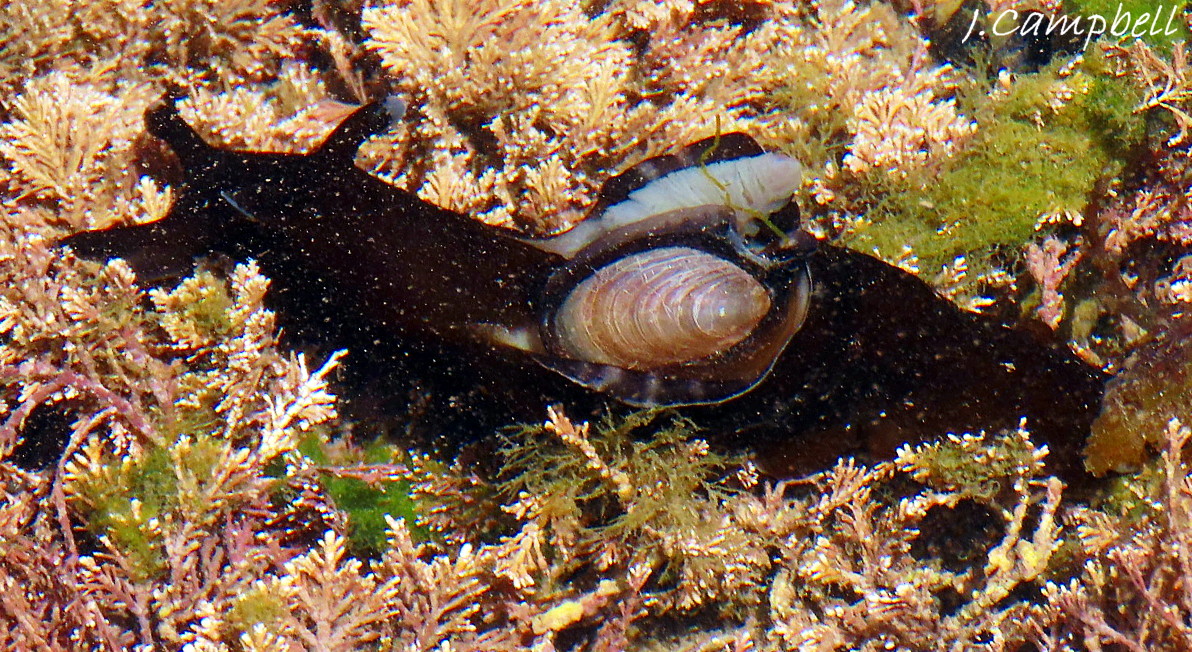Click image to enlarge with full caption. Main text below slider.
Aplysia punctata (Cuvier, 1803) Account revised August 2021
PDF available at www.researchgate.net/publication/353918067_Aplysia_puncta…
Current taxonomy: World Register of Marine Species (WoRMS) www.marinespecies.org/aphia.php?p=taxdetails&id=138758
Synonyms: Aplysia rosea Rathke, 1799; Aplysia hybrida J. Sowerby, 1806.
Meaning of name: Aplysia = that which cannot be washed; punctata = spotted.
Vernacular of just this species: Spotted sea hare (English); Môrwlithen glustiog (Welsh); Aplysie ponctuée (French); gemeiner Seehase (German); Pikasti morski zajček (Slovenian); Liebre de mar manchada (Spanish);
Vernacular of any Aplysia species: Sea hare (English); Lièvre de mer (French); zeehaas (Dutch); søhare (Danish); sjöhare (Swedish); Lepre marina (Italian);
GLOSSARY below.
Shell description
A. punctata has a rudimentary vestigial shell. Its height (longest dimension) is up to 40 mm, occasionally more; about 30% of the animal’s length. It is saucer-shape with a recurved, pointed umbo (rostrum) overhanging the concave interior, and there is an embayment on the right. It somewhat resembles a pectinid with asymmetrical “ears” either side of the rostrum.
The adult shell retains no trace of the spiral coiling of the veliger stage. It consists of two layers of conchiolin. The outer layer is the periostracum. The inner layer is transparent, imperceptibly calcified and limp on young specimens ( 01 Aplysia punctata ), and on older specimens is a translucent, thin, fragile, semi-calcareous layer, often fractured into pieces held in place by the periostracum ( 02 Aplysia punctata ). The periostracum layer extends to form a broad flexible border beyond the inner layer. The exterior is amber-coloured with a sculpture of growth lines, close-set concentric striae and a few indistinct radiating lines. The aperture occupies virtually the whole of the ventral/interior face. On a living animal, the shell is concealed by the mantle, except within a round foramen ( 03 Aplysia punctata ). There is no operculum.
Body description
The full-grown body length is about 70 mm and the usual maximum is 120 mm, exceptionally 200 mm ( 14 Aplysia punctata & 15 Aplysia punctata ). It has a large head and neck ( 04 Aplysia punctata). The snout has a centrally divided oral veil which is usually loosely rolled into forward-orientated oral tentacles and curled flaps in front of the mouth ( 05 Aplysia punctata). The appearance varies with the degree of rolling; sometimes flaps hang down from the oral tentacles ( 06 Aplysia punctata ). The snout is separated ventrally from the foot by a gutter (f 05 Aplysia punctata). The cephalic tentacles are also enrolled, but the edges are fused on the basal half; they resemble a hare’s ears ( 05 Aplysia punctata). Anterolaterally of each cephalic tentacle base there is a blue-black eye on a slightly raised mound of translucent unpigmented epithelium resembling a whitish iris ( 05 Aplysia punctata).
Two large parapodia arise from the approximate mid-point of the body and extend to about 25% body length from the posterior where they unite ( 07 Aplysia punctata ). An external seminal groove runs from a common genital aperture, close to the anterior of the right parapodium, along the neck to the opening to the penial sheath near the base of the right oral tentacle ( 08 Aplysia punctata ). Raised walls along the sides of the seminal groove meet firmly at their edges, but do not fuse, to form a tube lined with cilia that propel the contents. The penis is spatulate with curled up edges and has an external seminal groove. It is engorged and extended from the everted penial sheath during copulation ( 09 Aplysia punctata & 10 Aplysia punctata).
The parapodia can be held erect ( 11 Aplysia punctata, semi-prone revealing enclosed anatomical features ( 03 Aplysia punctata & 21 Aplysia punctata ), or folded down to conceal features ( 12 Aplysia punctata).
Colours and patterns on the external surfaces of body vary greatly between individuals www.nudibranch.org/Scottish %20Nudibranchs/aplysia-punctata.html (J. Anderson) , but usually there is a general progression in ground colour during growth from rose-red when small and feeding on red algae such as Delesseria, through brown or blackish-brown when on Laminaria to olive-brown when large and on Fucus (Eales, 1921). Many have fine spots of a darker shade of the ground colour arranged in elongate blotches, varying in prominence, which often form a reticulated pattern. In addition, some have white blotches. The edge of the parapodium often has a thin white rim, sometimes accompanied by black and/or reddish bands ( 13 Aplysia punctata ), and the tips of the tentacles and edges of foot may have similar colours. The dorsal face of the parapodium, usually held concealed against the body, is unpigmented greyish white, apart from its border.
The mantle, enclosed by the parapodia, covers the shell apart from a large round foramen, and, at the posterior-right, forms an erect funnel with the anus near its base ( 03 Aplysia punctata ). The shell covers the viscera and the anal funnel fits against the embayment on its right-posterior edge (). The anal funnel often protrudes when the parapodia are closed, but it is able to withdraw. The gill ( 21 Aplysia punctata & 22 Aplysia punctata ) is a thick set, plume-like structure of loose connective tissue and muscle fibre covered by a partly ciliated epithelium (Eales, 1921, plate I). It has thickened lobes in place of the thin filaments of typical ctenidia. It is located in the narrow mantle-cavity on the right of the parapodial enclosure ( 03 Aplysia punctata). It is affixed at its anterior end close to a yellow osphradium. The gill is usually concealed under the shell but may be erected above it if the oxygen level is sensed by the osphradium to be low. An unpigmented opaline gland is in the floor of the mantle cavity near the anterior-right of the parapodial enclosure and just to the posterior of the common genital opening ( 04 Aplysia punctata. & 21 Aplysia punctata ). The anterior of the foot is almost rectangular and sometimes expands into a circular outline ( 13 Aplysia punctata). The posterior of the foot is bluntly pointed. The pale, unpigmented, narrow sole ( 05 Aplysia punctata ) is sometimes hidden by the edges curling together ( 11 Aplysia punctata ) and it may form into a rounded sucker at the anterior ( 13 Aplysia punctata ), but rarely at the posterior (Thompson, 1976). There is no discernible subdivision of sole into regions (Eales, 1921).
Key identification features
Aplysia punctata
1. Parapodia unite at their posterior, c. 25% body length from posterior of body; see in Grigg (1949) ( 07 Aplysia punctata ). It swims rarely, if at all, and clumsily if it does.
2. Foramen ( 03 Aplysia punctata ), a round hole in the mantle that exposes the shell, is larger, relative to the animal’s size, than the foramen on A. depilans or A. fasciata.
3. Full-grown length about 70 mm, usual maximum 120 mm.
4. Foot occasionally expands into rounded sucker ( 13 Aplysia punctata at anterior but rarely, if ever, at posterior. The sole is whitish.
5. Occurs all round Britain except parts of southern North Sea and north east Irish Sea.
Aplysia depilans Gmelin, 1791
1. Parapodia unite at their posterior close to the posterior of the animal ( in Grigg, 1949) ( 16 Aplysia punctata). It is unlikely that it ever swims.
2. Foramen is smaller, relative to animal’s size, than foramen on A. punctata
3. Length frequently 120 mm or more, up to 300 mm.
4. Foot frequently expands at posterior into rounded sucker attached to substrate. Sole brown.
5. In Britain (2015), confined to south west England; breeds in Cornwall.
Aplysia fasciata Poiret, 1789
1. Parapodia do not unite at their posterior. See , as A. limacina, in Grigg (1949); frequently swims gracefully, see flic.kr/p/da9ojG (R. Fernandez); www.youtube.com/watch?v=x051Lw6LMBw#t=26 (M. Pontes).
2. Tiny foramen, pore-like on raised papilla (Grigg, 1949), is far smaller, relative to animal’s size, than foramen on A. punctata; often difficult to discern.
3. Length frequently about 200 mm, with weight nearly 2kg, but up to 400 mm (largest British gastropod).
4. Foot pointed at posterior.
5. Reliably recorded from Dorset, South Devon, Cornwall and Channel Islands; rare.
Aplysia parvula Mörch, 1863
This species was recorded for Britain (Bebbington & Brown, 1975) on the basis of morphological features of small A. punctata specimens. Eales (1921) reported that small red specimens grew and changed colour to typical A. punctata when fed on non-red algae in captivity, so she dismissed their identification as a distinct species. Recent DNA studies (Golestani et al. 2019) found that A. parvula is confined to the tropical western Atlantic, and no DNA evidence for it was found in specimens examined from the north eastern Atlantic or Mediterranean.
Habits and ecology
A. punctata lives in shallow unpolluted water and occasionally on shores at LWS where its algal food grows; including red algae, Ulva ( 04 Aplysia punctata) and Fucus.
Respiration: There is no obvious inhalent siphon; Jeffreys (1869) suggested that inflow was via the foramen, but this seems unlikely. Water is probably taken in between the body and anterior of the parapodia to the narrow mantle cavity on the right containing the gill ( 03 Aplysia punctata). The water passes over the osphradium near the anterior attached-end of the gill. The current is created by cilia on the gill and, probably, on other surfaces. The osphradium tests the water-quality; if it is oxygen deficient, the gill may erect itself clear of the overhanging shell for better access to oxygenated water (Eales, 1921). The exhalent current leaves the animal via the anal funnel, taking faeces with it ( 17 Aplysia punctata).
Defence : A. punctata is usually well camouflaged because its colour is often similar to alga it is feeding on. When irritated, the opaline gland ( 04 Aplysia punctata) can release via the anal funnel ( 17 Aplysia punctata ) an acrid, white, viscous secretion, mixed with purple dye from the ink gland, to repel and confuse attackers. There are a few uncertain reports of predation on adults, but crustacea eat the spawn.
Reproduction: Breeding is recorded in February-November in Britain, but is most usual in spring. A. punctata is a simultaneous hermaphrodite, but distant spacing and positioning of the male and female orifices ( 09 Aplysia punctata) prevent mutual interchange of gametes between a side-to-side pair in the manner of nudibranchs. One, acting as male, climbs astride another from behind and with the anterior of its foot firmly grips the mantle and shell (through the foramen) of the lower acting female. The penis of the acting male, engorged by blood and extruded by eversion of the internal penis sheath, is inserted into the vaginal part of the other’s common genital aperture ( 09 Aplysia punctata). Semen from the acting-male passes from its common genital aperture, through the external seminal groove on its neck and head, edge of the penial sheath and penis into the acting-female ( 10 Aplysia punctata. Often a chain of mating individuals forms, enabling all, except those at each end of the chain, to act as male and female simultaneously ( 09 Aplysia punctata).
A. punctata often extrude spawn during coupling, and it often passes from the common genital opening along the seminal groove, escaping through a wrinkle part-way along it or continuing to emerge (confusingly) at the penial aperture. The spawn is a long string of spherical egg-capsules ( 18 Aplysia punctata. ). There are about 500 capsules in each cm of spawn-string ( 19 Aplysia punctata ), and each capsule contains 3 or 4 ova. Copulation/ovipositing lasts several hours or even days, and the string is extruded intermittently in sections, each of which curls and tangles with the others (Eales, 1921). Its colour changes with time, so sections of string issued at different times by a single individual may have different shades from each other with abrupt colour changes corresponding to pauses in laying ( 20 Aplysia punctata ). The final colour is brown before veliger larvae emerge into the plankton. A mating/ovipositing chain of individuals results in a tangled mass of spawn strings. A sample mass from the River Yealm, Devon, had an estimated 135 000 ova (Thompson, 1976). Veliger larvae metamorphose after 20-22 days in the plankton at 15ºC into rose-red crawlers, about 5 mm long, feeding on red algae in shallow water (Thompson, 1976).
Distribution and status
A. punctata occurs from northern Norway to the Mediterranean, but is scarce or absent from the continental coast of the southern North Sea and extends into the Baltic no further than the Kattegat, GBIF map www.gbif.org/species/5191252 . It is found in unpolluted water all round Britain and Ireland, except in the north-east Irish Sea. the North Sea from Flamborough Head to Kent and much of the east coast of Scotland where it is absent or scarce. U.K. map NBN species.nbnatlas.org/species/NBNSYS0000173903
Acknowledgements
This account would not have been possible without the assistance of Jim Anderson, Heather Buttivant, Charlotte Cumming, David Fenwick, Andy Horton, David Kipling, Paula Lightfoot, Penny Martin, Simon Taylor and the photographers whose images have been linked to the account; their names are given next to the links. I gratefully thank them all.
References and links
Bebbington, A. 1992. British Aplysia species. Porcupine Newsletter Vol.5 no 6: 131 – 133. pmnhs.co.uk/wp-content/uploads/2011/11/046-PNV5N6DEC92.pd…
Bebbington A, & Brown, GH. 1975. Aplysia parvula Guilding in Morch, an opisthobranch new to the British fauna. Journal of Conchology 28: 329–333.
Eales, N.B. 1921. Memoir 24 Aplysia. Proceedings and transactions of the Liverpool biological society. 35: 183 – 280.
archive.org/stream/proceedingstr35192021live#page/182/mod…
Forbes, E. & Hanley S. 1849-53. A history of the British mollusca and their shells. vol. 3 (1853), London, van Voorst. (As Aplysia hybrida); pp. 554-556. archive.org/stream/ahistorybritish05forbgoog#page/n568/mo…
Garstang, W. 1890. A complete list of the opisthobranchiate mollusca found at Plymouth; with further observations on their morphology, colours and natural history. J. mar. biol. Ass. U.K. 1(4): 399-457. plymsea.ac.uk/50/ .
Golestani, H., Crocetta, F., Padula, V., Camacho-garcía, Y., Langeneck, J., Poursanidis, D., Pola, M., Baki yokeş, M., Cervera, J.L., Jung, D., Gosliner, T.M., Araya J.F., Hooker, Y, Schrödl, M. and Valdés, Á. 2019. The little Aplysia coming of age: from one species to a complex of species complexes in Aplysia parvula (Mollusca: Gastropoda: Heterobranchia) Zoological Journal of the Linnean Society. 20, 1–52
Grigg, U.M. 1949. The occurence of British Aplysia. J. mar. biol. Ass. U.K. 28(3): 795-805. plymsea.ac.uk/id/eprint/1391/ [has A. fasciata as A. limacina]
Høisæter, T. 2009. Distribution of marine, benthic, shell bearing gastropods along the Norwegian coast. Fauna norvegica 28: 5-106. www.ntnu.no/ojs/index.php/fauna_norvegica/article/view/563
Jeffreys, J.G. 1862-69. British conchology. vol. 5 (1869). London, van Voorst. pp.1-8 archive.org/stream/britishconcholog05jeff#page/n9/mode/2up .
McKay, D. & Smith, S.M. 1979. Marine mollusca of East Scotland. Royal Scottish Museum, Edinburgh.
Thompson, T.E. 1976. Biology of opisthobranch molluscs vol.1. London, Ray Society.
Current taxonomy: World Register of Marine Species (WoRMS) www.marinespecies.org/aphia.php?p=taxdetails&id=138758
Glossary
aperture = mouth of gastropod shell; outlet for head and foot.
anterolateral = situated in front and to the side of.
cephalic = (adj.) of or on the head.
cilia = (sing. cilium) microscopic linear extensions of membrane that move in rhythmic waves to create locomotion, or that move particles and liquids e.g. inhalent water currents. (Scanning electron microscope image at 18 Lepidochitona cinerea )
ciliated = (adj.) coated with cilia.
conchiolin = horny flexible protein that forms the periostracum and a matrix for the deposition of calcium carbonate to create other shell-layers.
ctenidium = comb-like molluscan gill; usually an axis with a row of filaments or lamellae on one or two sides.
ELWS = extreme low water spring tide (usually near March and September equinoxes).
epithelium = tissue forming outer layer of body surface and lining the alimentary canal and other hollow structures
everted = turned inside out and, like a sock.
foramen = natural, non-accidental, opening.
lobate = having or resembling lobes.
LWS = low water spring tide.
mantle = sheet of tissue that secretes the shell and forms a cavity for the gill in most marine molluscs. Confined to the shell-interior of most British shelled-gastropods, but also covers exterior on Aplysia.
opaline = acrid, white, viscous secretion used with purple ink by Aplysia to repel attackers.
operculum = plate of horny conchiolin, rarely calcareous, used to close shell aperture. Absent from Aplysia.
osphradium = organ for testing water quality, usually near the gill.
parapodia = (sing, parapodium) flap-like, lateral outgrowths of foot, usually held up against the sides of some sea slugs.
pectinid = member of the family Pectinidae (scallops).
periostracum = thin horny layer of chitinous material often coating shells.
plankton = animals and plants that drift in pelagic zone (main body of water).
plicate = corrugated so ridges and grooves alternate with each other on either side of axis.
rostrum = beak-like process on shell.
semen = fluid containing sperm.
seminal = relating to or containing semen.
striae = (sing. stria) usually parallel, slight, fine or narrow furrows, ridges, stripes, or streaks.
umbo = (pl. umbones) earliest part of the shell of a bivalve and some bivalve-like gastropod shells, such as in Aplysia punctata. It terminates in a beak which is best seen on an interior view.
veliger = shelled larva of marine gastropod or bivalve mollusc which swims by beating cilia of a velum (bilobed flap).
